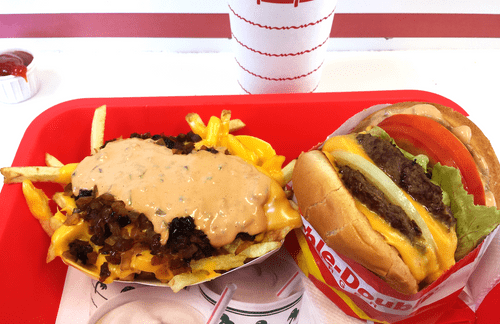Catalyte finds extraordinary developers from unexpected places. Tony Richards is one of those developers.
A fast food worker in the Bay Area, Tony moved to Chicago without a safety net to join our apprenticeship program. A year later, he’s entrenched in a new career and already paying it forward by training the next class of Catalyte developers.
Tony shared the story of his transition from the service to IT industries on Thrive Global. He shared tips for others looking to make a similar career shift.
You can read the full column below.
How I went from flipping burgers to writing code
Fast food prepared me to be a better software developer, but there were still a few surprises
In May 2018, I made what many might consider to be a rash decision. Over the course of a weekend, I quit my job at In-N-Out Burger in the Bay Area and moved to Chicago to take part in a software development apprenticeship. I had no formal background in programming, no apartment lined up and minimal savings to sustain me through the five months of skills development.
Now, before you start to worry, everything worked out fine. Thanks to the graciousness of friends, I had a couch to crash on. I completed the development portion of the apprenticeship and was hired as a software developer. I’m a year into an amazing career I never expected to have.
Over this year of transition, I’ve had time to reflect on the differences between working in the service and tech industries. There have been new challenges that I’ve had to adjust to, but also plenty my restaurant experience has given me a leg up on. Here’s what I’ve learned, for anyone looking to make a similar transition.
It’s still hard work, just different
I expected my transition to software development to lessen my exhaustion. Hooray! I don’t have to lift 40-pound boxes of lettuce all day. But, as I quickly learned, working on a computer can still be tiring.
Writing great code requires a level of agility, planning, adjustment and self-direction I had to get used to. I am now in an environment where I don’t know what the outcome of my work will precisely look like until it’s done. This demands a different sort of energy than assembling burger after burger.
One form of labor isn’t better than the other. They are just different. When I worked in the service industry, I came home from a bad day physically exhausted, and had dreams about working fries. Now, if I come home from a bad day mentally exhausted, I can still see lines of code floating in my field of vision when I close my eyes.
Attention to detail matters everywhere
We often talk in our planning meetings about user experience: how can we make our software as easy-to-use as possible?
Anyone who’s worked in retail or restaurants understands this. Stores are designed with user experience front and center. Everything from the menus, the setup of kitchen equipment, the layout of the building and even the way we speak to you is designed to enable the most expedient process for the customer possible.
When you’re in this world, you become attuned to notice when something is wrong and interfering with the customer experience. Is every ingredient on this burger visible? Are we using the right kind of packaging? Did the customer get enough food for each member of their party? It’s your job to know the correct pattern and return it to normal as soon as you see something’s different.
This ability has served me well in writing code. What is code other than patterns? This is how it should look if you want it work. If you notice that it looks off, chances are you need to fix it, or else you’ll deliver a poor user experience. Attention to detail and putting the customer first means many service workers have the mindset to become great developers.
Dealing with expanded financial possibilities
According to the Bureau of Labor Statistics, the average hourly wage for a fast food cook is $10.89. I was lucky enough to work for In-N-Out Burger, a company known for above-average wages. But those were quickly eaten up by the astronomical cost of living in the Bay Area. Like many Americans, I never had much disposable income or ability to save for my future.
I’m now in a position where I have the financial means to start a retirement account and budget for what I want, not just what I need. This comes with its own set of challenges and has, surprisingly, sometimes led to unexpected stress.
Financial literacy isn’t something most people are taught in school. The difference between a 401(k) and an IRA, or how much of your income should go to rent versus healthcare, aren’t common knowledge.
Old financial habits are hard to break. If you’re used to living paycheck to paycheck, you’ll tend to continue doing it – even if that paycheck is two-to-three times larger.
Learn to save. Learn basic financial and budgeting strategies. Take advantage of automatic savings plans. But cut yourself some slack if you indulge in old habits. You’re not alone.
People have asked me what’s the best aspect of making the transition from foodservice to software development. Aside from the basic – not smelling like onions at the end of the day – I have to say it’s being part of something bigger than myself. I’m part of the future of work, building the foundations of a more equitable and accessible world. I took a leap and landed on my feet. Hopefully, my story can convince others that they can stick the landing too.


